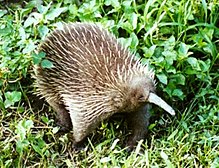Tachyglossa
| Echidna Temporal range: Miocene–Holocene |
|
|---|---|
 |
|
| Western long-beaked echidna | |
| Scientific classification | |
| Kingdom: | Animalia |
| Phylum: | Chordata |
| Class: | Mammalia |
| Order: | Monotremata |
| Suborder: | Tachyglossa |
| Family: |
Tachyglossidae Gill, 1872 |
| Species | |
|
Genus Tachyglossus |
|
Genus Tachyglossus
T. aculeatus
Genus Zaglossus
Z. attenboroughi
Z. bruijnii
Z. bartoni
†Z. hacketti
†Z. robustus
Genus †Megalibgwilia
†M. ramsayi
†M. robusta
Echidnas /ᵻˈkɪdnə/, sometimes known as spiny anteaters, belong to the family Tachyglossidae in the monotreme order of egg-laying mammals. The four extant species, together with the platypus, are the only surviving members of the order Monotremata and are the only living mammals that lay eggs. The diet of some species consists of ants and termites, but they are not closely related to the true anteaters of the Americas. Echidnas live in Australia and New Guinea.
...
Wikipedia
